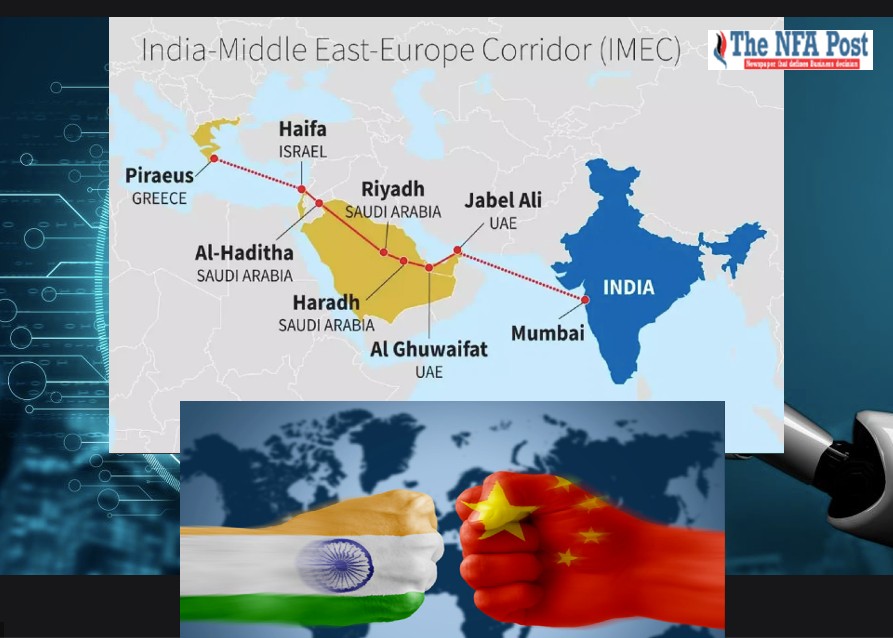Anti-trust expert John Gong describes India–Middle East–Europe Economic Corridor as a “big pie in the sky” and “vaporware”. Beijing-backed European lobbyist Hussein Askary labels IMEC “impotent”
Bengaluru, NFAPost: A well-known Chinese anti-trust expert who works closely with the country’s Ministry of Commerce has described the proposed India–Middle East–Europe Economic Corridor (IMEC) “as a big pie in the sky” which “sounds like crazy” because it doesn’t involve Jordan as a signatory.
Beijing University of International Business and Economics Professor of Economics John Gong made the comments on Sunday while participating in “Dialogue”, a current affairs talk show aired by state-owned CGTN. John wondered how a railway line could be built between Israel and Saudi Arabia without involving Jordan.
“It’s like saying India built a railway line to Mongolia without China knowing about it or approving it,” he told the host Xu Xinduo.
“If you look at the signatories to the MoU (memorandum of understanding) from the White House press release, clearly Jordan is not involved at all. It represents a little bit of arrogance and a condescending attitude towards a sovereign country,” said Beijing University of International Business and Economics Professor of Economics John Gong.
This over-the-top attempt to run down a prestigious project unveiled at the just-concluded New Delhi G20 summit is the second such incident within the course of a few days where prominent Chinese experts have gone salty against India.
Only last Wednesday, the Hong Kong-based South China Morning Post reported how a leading Chinese lunar scientist tried to poke holes in India’s Chandrayan-3 lunar mission saying its lander did not make touchdown either at the moon’s south pole or in its polar region.
The participants in Sunday’s Dialogue were convinced that the IMEC is positioned against China’s Belt and Road Initiative (BRI).
Hussein Askary, Vice Chairman of the Belt and Road Institute in Sweden — a lobbying organization for the BRI in Sweden —, used even more raunchy language while contrasting BRI with infrastructure initiatives backed by the USA like IMEC. “The BRI is a potent initiative. The others are impotent.”
He went on to add, “This (IMEC) is a geopolitical empty shell like the ‘Build Back Better World’ and ‘Global Gateway’. There’s no substance to it. Simply geopolitics with very little to do with economics. Like other US-proposed projects, this project too is exclusive. You create a club of nations, who you think has converging interests against someone else. The BRI is all inclusive. It includes everyone. Even the USA is welcome.”
John echoed his views. “It (IMEC) is more like a PR campaign from which Washington can reap some geopolitical, geostrategic benefits. It’s a vaporware.”
China has wooed around 150 nations who have either signed up or have indicated interest in BRI — its prestigious infrastructure project launched in 2013. India and Bhutan are not signatories, though neighbors Afghanistan, Bangladesh, Nepal, Pakistan, and Sri Lanka are participating.
An FT report said in April that the $1 trillion project has seen a spiraling of bad loans, with $78 billion turning sour over the past three years alone.
Nevertheless, India’s absence seems to rankle Beijing. “India, unfortunately, is being pulled into a different sphere away from China. This is the only purpose of this whole undertaking,” Askary told Xu in response to another question.
Potshots Against Chandrayan Citing Technicalities
The barbs against Chandrayan-3 were based on technicalities. The mission’s Vikram lander touched down at the moon’s latitude of around 69 degrees south. On earth, the south pole is defined to be between 66.5 degrees and 90 degrees south latitude.
But Ouyang Ziyuan, the chief scientist of China’s first lunar mission, contends that the moon’s polar region is a narrow stretch between “between the latitudes of 88.5 degrees and 90 degrees”.
Ouyang told the official Science Times newspaper that Vikram’s landing point was within moon’s southern hemisphere, but not in the polar region. Nasa has a more expansive view on the moon’s polar region, contending that it lies between 80 degrees to 90 degrees south latitude.
Regardless, there’s universal consensus that the Chandrayan-3 mission landed at a higher latitude than ever achieved by previous missions.





